Noh Oshima Bulletin
The cover stories of our bulletins published twice a year.
№20 cover story (2009/09/15)
On a day in August
OSHIMA Kinue
At a university of music, I served as a lecturer for the course of renewing the teacher's license on a day in August this year. The course was for the music teachers in elementary schools, junior and senior high schools, orienting them to the traditional music of Japan. The government guidelines for teaching nowadays oblige the teachers to introduce the Japanese music (and also Japanese music instruments). But that would be a difficult task for them because they have spent most of their time learning the Western music.
Surely the Japanese music also has a wide variety, but I thought I would let them experience the Nohgaku to get the feeling of "ma (space)" and "iki (breath)" which all kinds of the Japanese music have in common.
 Anyway, practice makes perfect! I made them practice a passage from "Senshuraku" repeatedly, by utai, ko-tsuzumi, and o-tsuzumi respectively. We neither have any detailed sheets of music, a metronome to check the tempo, nor a cue to adjust the musical interval. We only raise our voices from our stomach by coordinating with each other's breath. The teachers, who were too reserved to utter a sound at first, came to sing 'utai' and shout 'kakegoe' strongly enough, as they must have gained confidence in their "ma" by practicing repeatedly. After the course, the teachers wrote in their reports that they would like to introduce this Nohgaku method into their daily school lessons. For me, the course of this August was a wonderful experience.
Anyway, practice makes perfect! I made them practice a passage from "Senshuraku" repeatedly, by utai, ko-tsuzumi, and o-tsuzumi respectively. We neither have any detailed sheets of music, a metronome to check the tempo, nor a cue to adjust the musical interval. We only raise our voices from our stomach by coordinating with each other's breath. The teachers, who were too reserved to utter a sound at first, came to sing 'utai' and shout 'kakegoe' strongly enough, as they must have gained confidence in their "ma" by practicing repeatedly. After the course, the teachers wrote in their reports that they would like to introduce this Nohgaku method into their daily school lessons. For me, the course of this August was a wonderful experience.
At the beginning of this August I visited the U.S., where I participated in the 15th memorial performance of "Noh Training Project" presided over by Mr R. Emmert. Although some of the participants were not able to speak the Japanese language, every one of them performed splendidly after having trained so hard. I could not but respect them. After this performance we practiced the brand-new English Noh "PAGODA", which will be performed on stage in December this year. I hope to challenge this piece, along with the American pupils facing earnestly the Japanese traditional art "Nohgaku".
№19 cover story (2009/04/15)
Modern Life and Nohgaku
OSHIMA Teruhisa
 As though I were a medieval, some may consider if I introduce myself as a Nohgaku performer. I am a modern person! But for those people, Noh is an art of the ancient times, far apart from the present day. The art Noh was established as many as seven hundred years ago, but it is a living art, one of the most long-lived stage arts. In order to preserve this art, in every period of time my senior performers have created its appropriate mode. My superiors must have made their best endeavors to combine their art with their times. The topics dealt with Nohgaku are universal, which people hold in general as long as they are alive: the feelings to the loving one, the envy and hatred because of love, the valor at a battle, the loser's aesthetic, the hellish agony, and the mercy by Buddha.
As though I were a medieval, some may consider if I introduce myself as a Nohgaku performer. I am a modern person! But for those people, Noh is an art of the ancient times, far apart from the present day. The art Noh was established as many as seven hundred years ago, but it is a living art, one of the most long-lived stage arts. In order to preserve this art, in every period of time my senior performers have created its appropriate mode. My superiors must have made their best endeavors to combine their art with their times. The topics dealt with Nohgaku are universal, which people hold in general as long as they are alive: the feelings to the loving one, the envy and hatred because of love, the valor at a battle, the loser's aesthetic, the hellish agony, and the mercy by Buddha.
The more excellent the Noh pieces are, the clearer, more deeply and beautifully the topics reach the nature of the human being.
As we have made a great advance in science and technology, somehow we misunderstand that the our character is getting better. We have become able to do more movements on the stage,to be sure, yet as the result there have arisen something that cannot be expressed. We may have missed or forgotten some points of view or sentiment that our pioneers had acquired.
My aim as a modern Nohgaku performer is to offer you some opportunities where you realize the universal comparing with the modern within my Noh performings.
№18 cover story (2008/09/15)
"Sotoba-Komachi"
OSHIMA Masanobu
 Our regular Noh-performances, which my father Hisami started in 1958, the 33rd year of Showa Period, will have attained the fifty-year-long continuation in this autumn. At this epoch-making stage, I perform "Sotoba-komachi" for the first time on the 30th of this November. This piece has a keen remembrance to me.
Our regular Noh-performances, which my father Hisami started in 1958, the 33rd year of Showa Period, will have attained the fifty-year-long continuation in this autumn. At this epoch-making stage, I perform "Sotoba-komachi" for the first time on the 30th of this November. This piece has a keen remembrance to me.
I watched the stage of this piece by Mr. GOTO Tokuzo about two years after I became an apprentice at the head family of Kita-ryu. As I was not allowed to get together onto the stage yet, I watched his performance from the side room. All of the staff were extremely nervous, much more than usual. Roppeita the 14th, who was old enough, supported it as 'Koken', a guardian. The performance was so wonderful; substantial and independent. That was my first experience to feel that Noh is such a wonderful art. At that time, however, the piece seemed far more distant one from me.
Her vitality which never decays until her old age, her regret and pity, her whole life as a talented woman; I will try to express Ono-no-komachi with various aspects at my performance.
The experts of every field are going to assist me. I wish all of you a warm support as I do my very best.
№17 cover story (2008/03/15)
With a Fresh Mind
OSHIMA Kinue
The Education Board of Hiroshima Prefecture awarded me the Prize of Education Encouragement. I would like to express my sincere gratitude.
The traditional culture has been recently revaluated and with its current has been taken up by schools and various media. As a Nohgaku lecturer, we also have had more and more opportunities at colleges and schools. Now that things change day by day and a lot of information is flooded around us, the constancy of tradition may be pursued all the more.
We hope the children have the pride and love of their native country and town through learning the traditional culture. On the basis of their own culture they should become citizen of the world, where we do hope to help them.
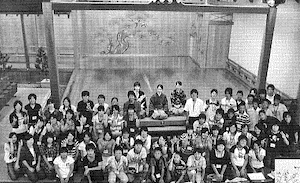 We cerebrate the 50th Anniversary of "the Kita-ryu Oshima Nohgaku Do Regular Performances." Half a century has passed since my grandfather Hisami started "Noh-gaku Lesson" in 1958. He named the event "Lesson" because it should be the practicing stage both the Nohgaku performers and the audience. Though the name was changed, we have held his idea and kept the lesson as the basis of our daily activities.
We cerebrate the 50th Anniversary of "the Kita-ryu Oshima Nohgaku Do Regular Performances." Half a century has passed since my grandfather Hisami started "Noh-gaku Lesson" in 1958. He named the event "Lesson" because it should be the practicing stage both the Nohgaku performers and the audience. Though the name was changed, we have held his idea and kept the lesson as the basis of our daily activities.
№16 cover story (2007/09/20)
Performing 'Shite-Tsure'
OSHIMA Teruhisa
Among the stage performances, Nohgaku has some differences from others. One of them is a strict division of the roles. We, the Shite people do not play a Waki part and vice versa. We do not play Kyogen either. The people of Shite family play a Shite part, Ji-utai, Koken (guardian), and a Shite-Tsure part (attribute). Nowadays as I play a Shite-Tsure part more often, I would like to talk about what I have found out while playing a Shite-Tsure part and some difficulties a Tsure part has.
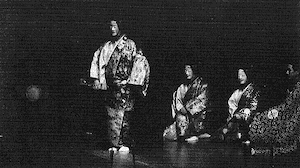 As a Shite part has several roles, so has a Tsure part. Mainly a young woman, a man without a mask, or an old woman. Some appear briefly at the beginning of the play, others stay long, longer than a Shite part, enduring the pain of my legs. But the point is that you play second string and arouse the mood of the stage, recognizing the role of Tsure. Too thin presence, however, cannot add charm to the stage. Consideration really needs experience.
As a Shite part has several roles, so has a Tsure part. Mainly a young woman, a man without a mask, or an old woman. Some appear briefly at the beginning of the play, others stay long, longer than a Shite part, enduring the pain of my legs. But the point is that you play second string and arouse the mood of the stage, recognizing the role of Tsure. Too thin presence, however, cannot add charm to the stage. Consideration really needs experience.
There is a Noh piece named "Matsukaze." One of the most difficult Tsure parts I have ever played. As Murasame(Shite's young sister) I went out on the stage with Matsukaze(Shite), I had to keep standing on the stage for almost two hours, with no Nakairi(rest time). I had to recite a lot of complicated, delicate, but famous phrases along with Shite, dance together with Shite having a narrow sight through the Noh mask. Besides, in the end, my legs became half paralyzed ---.
Some say that the Shite part of "Matsukaze" is harder than that of "Dojo-ji" in a sense; The Tsure part of "Matsukaze" is all the harder, because a definite but reasonable existence is to be performed. I was exhausted mentally rather than physically. Every essence of Tsure is contained in the role of Murasame, I think.
Since Noh is a "general art," every part has to hold a high level so as to achieve a good stage. I would like to advise you to watch and listen other many actors and players except for a Shite part, which will surely makes Noh stages more attractive.
№15 cover story (2007/04/10)
A Nohgaku Appreciation Lecture at the Senior Highschool
OSHIMA Masanobu
Last autumn, we held a lecture to the students at the auditorium of the prefectural senior highschool, Fukuyama Seishikan. It is a historic school, a former Clan School, and my father's and my grandfather's alma mater.
In 1945, when the stage of our house was burned down, my father HISAMI used to perform Nohgaku at Seishikan auditorium for several years and gave Utai practice to the faculty and the students of Nohgaku Club. In those days, the school was located in the center of Fukuyama City; Now it has moved northward to the hilltop. If HISAMI were alive, he would be so delighted.
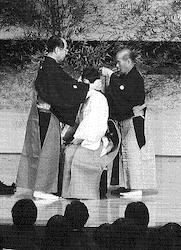 On the lecture day, we adopted "the Work Shop" style. The program was i) A talk about Noh and a short-time practice of Utai, ii) to wear a Noh-shozoku, iii) to play a Noh instrument, iv) to appreciate a Noh-bayashi, v) to appreciate the half-Noh "Tomoe." Their response was great, though the very first experience for most of them.
On the lecture day, we adopted "the Work Shop" style. The program was i) A talk about Noh and a short-time practice of Utai, ii) to wear a Noh-shozoku, iii) to play a Noh instrument, iv) to appreciate a Noh-bayashi, v) to appreciate the half-Noh "Tomoe." Their response was great, though the very first experience for most of them.
A few days later, the principal of Seishikan wrote to us: "--- through appreciating your Nohgaku lecture, all of us, the students, the faculty, and the parents are happy to feel that the art of Nohgaku is close to us. And also we feel responsibility to inherit the traditional art at Fukuyama. We do thank you for your performance."
Nohgaku was the first to be registered as the Japanese Traditional Culture on UNESCO's World Heritage list and is in the spotlight from the world. But, as a matter of fact, as the Japanese people with the Pre-War Education are becoming fewer, the number of the Nohgaku lovers are declining these days. We have to cultivate the educational field so as to give the students more opportunities to experience the Japanese traditional culture, so that they can appreciate and take over Nohgaku from us.
№14 cover story (2006/09/15)
The Power of 'Kata(form)'
OSHIMA Kinue
This summer I gained two significant experiences: One is that I was invited as a lecturer to "the Noh Training Project." And the other is that I performed a new Noh piece in the Okuri-bi Dedication Noh at Zuisen-ji Temple in Mihara, Hiroshima Prefecture. (Okuribi is the bonfire to see off the spirits who visited the living people during the Bon Festival in summer.)
In the United States, their earnest and enthusiasm surprised me and I was really satisfied with my stay there. While giving a practice of a Shimai, I recognized the importance of the form. As the forms of Noh are abstract and simple, at first glance, they appear to be a meaningless repetition. Moreover, there is a lot of restriction because you have to fit your body into the form. But because of the form, you can get blank/margin; and the blank can create your mental width. The simpler the stronger, you keenly realized that.
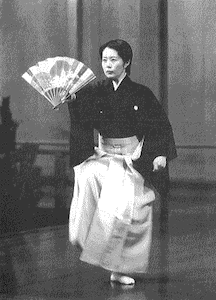 By performing a brand-new Noh piece, I realized how perfect and how great the traditional Noh pieces are. A Noh piece which already existed from the old times is an object we have hard time to master, by memorizing and practicing a lot. As for a new piece, we have to understand the construction of Fushi(tune) and Kata(form) so as to rhyme the tune and perform the form. I was able to learn much from the other side of the Noh.
By performing a brand-new Noh piece, I realized how perfect and how great the traditional Noh pieces are. A Noh piece which already existed from the old times is an object we have hard time to master, by memorizing and practicing a lot. As for a new piece, we have to understand the construction of Fushi(tune) and Kata(form) so as to rhyme the tune and perform the form. I was able to learn much from the other side of the Noh.
Noh has not only the form of the motion, but the whole Noh is made of the form in a sense, the construction itself, the melody of Utai, the motion of Hayashi, and so forth. A long, long time and many, many seniors have brushed up every part of the Noh pieces, which has a complished form a single person cannot possibly think of. How long does it take for me to gain the form, I wonder. My grandfather Hisami murmured his favorite phrase, as his master Roppeita the 14th said, "When I comprehend the Noh, my body does not move."
№13 cover story (2006/03/20)
A Guide to Nohgaku Appreciation
OSHIMA Teruhisa
At the Regular Noh Performance in Fukuyama, the performers give a short speech explaining some about the Noh piece in advance. This derives from the beginning of the event, when at first my grandfather Hisami named it "Nohgaku Lesson." He wanted both the performers and the audience to learn a lot more deeply. Nowadays the Noh performance with explanation is held here and there, but at that time this kind of Noh events were rare and some even said scornfully that OSHIMA made a speech before the Noh performance.
Because my father is poor at speaking in public, I was made to explain the programs, not understanding them enough yet in my teens. Talking about a Noh piece for about ten minutes, and not accustomed to making a speech, was so difficult beyond imagination that I wanted to quit the task at times.
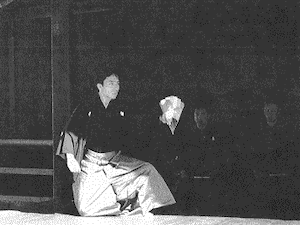 When I went to Tokyo later and watched several stages, I began to think that the traditional culture may be separating from the ordinary daily life of the Japanese and there may be something they cannot get easily, especially for the beginners. Since then I have searched after the opportunities to become a bridge between the stage and the audience.
When I went to Tokyo later and watched several stages, I began to think that the traditional culture may be separating from the ordinary daily life of the Japanese and there may be something they cannot get easily, especially for the beginners. Since then I have searched after the opportunities to become a bridge between the stage and the audience.
The Noh, which use no large-scale stage settings, sometimes transfer the scene through space or time freely, much more freely than any other stage art adopts. Though the performers do not think that extraordinary, those who are unfamiliar with the Noh expression may not follow us. I would like to keep talking, hopefully answering the simple questions I myself used to have at my youth.
№12 cover story (2005/09/15)
Performing at Tomo-no-Ura
OSHIMA Masanobu
In this autumn on the Noh stage of Nunakuma Shrine at Tomo, Fukuyama, we hold three Noh-performance events named "Setouchi Enjoy Stage" as a part of Hiroshima Prefecture Major Sightseeing Campaign.
The first one, on October 1, we perform a brand-new Noh piece "Tomo no Muro-no-ki," which was first played at the National Nohgaku Do in 2002, at our Nohgaku Do in Fukuyama in 2004. This will be the third time, but for the first time on the stage of Tomo-no-ura. The author is a Fue-kata (flutist) Mr. HOASHI Masanori, who was born in Tokyo and now lives in Kyoto. He is a great fan of "Man'yoshu"(a Japanese ancient anthology), and also he loves the town of Tomo. Otomo no Tabito comes across Kan Chazan over time; Tabito has a sad and brief encounter with her wife Iratsume. Based on a classical mode, the universal conjugal affection is expressed on the Noh stage built by TOYOTOMI Hideyoshi more than 400 years ago.
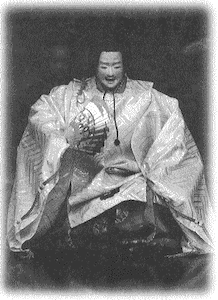 The second on October 8 and the third on November 5 are an event of Nohgaku with explanation, so that even the beginners can enjoy Noh. The second is "Takasago," and the third is "Hagoromo," both will be held as "Hannoh( half Noh )." At the same time, the local elementary pupils and junior highschool students exhibit their accomplishment from their Noh lessons. I hope that you come and see the children work seriously on the traditional art.
The second on October 8 and the third on November 5 are an event of Nohgaku with explanation, so that even the beginners can enjoy Noh. The second is "Takasago," and the third is "Hagoromo," both will be held as "Hannoh( half Noh )." At the same time, the local elementary pupils and junior highschool students exhibit their accomplishment from their Noh lessons. I hope that you come and see the children work seriously on the traditional art.
The town Tomo-no-ura has a history of two thousand years; and the stage of Nunakua Shrine is a venerable one, on which the Founder of Kita-ryu Family performed four some hundred years ago. We feel grateful and honorable to have an opportunity to perform there.
№11 cover story (2005/04/15)
The 200th Memorial Performance, as a Passing Point
OSHIMA Masanobu
In this February, my senior Mr. TOMOEDA Akiyo performed "Kiyotsune" and I played "Ema Nyotai" in our Regular Noh Performance, which was the 200th counted from the first one by my father Hisami in 1958. We deeply thank everyone for supporting us.
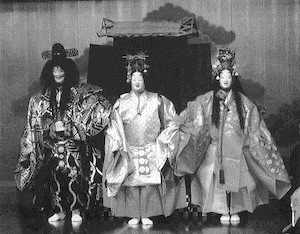 After that first Regular Performance, I went up to Tokyo to become a pupil of the Kita-ryu head family and then followed my father for some fifty years. Our regular performances have provided my father, me, and my children with an ample opportunity of practice and presentation. After the war the stage was rather mean, but my father constructed the present Nohgaku Do in 1971 and I performed "Dojo-ji" at its completion presentation. After a rush work for half a year the wall was wet and not fully equipped yet, I clearly remember the day of being puzzled and excited.
After that first Regular Performance, I went up to Tokyo to become a pupil of the Kita-ryu head family and then followed my father for some fifty years. Our regular performances have provided my father, me, and my children with an ample opportunity of practice and presentation. After the war the stage was rather mean, but my father constructed the present Nohgaku Do in 1971 and I performed "Dojo-ji" at its completion presentation. After a rush work for half a year the wall was wet and not fully equipped yet, I clearly remember the day of being puzzled and excited.
Now, in the middle of the stage, I see the footprint of my father, digging in by the bottom of his socks. He practiced and practiced to satisfy himself, performed big Noh pieces, and played various works. An admirable life.
Many Kita-ryu Head Family honorable members, Mr. GOTO Tokuso, and Mr. TOMOEDA Kikuo came several times to perform in the regular performances. Those were a valuable chance for every one of us to acquire discipline and appreciation.
The 201st Regular Noh Performance will be held as the first anniversary of my father Hisami's death, the program is "Shiro-tamura" by Mr. KANEKO and "Saigyo-zakura" by myself, the latter was my father's last piece in April of 1997.
